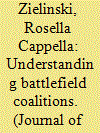|
|
|
Sort Order |
|
|
|
Items / Page
|
|
|
|
|
|
|
| Srl | Item |
| 1 |
ID:
186090


|
|
|
|
|
| Summary/Abstract |
Under what conditions do battlefield coalitions fight as greater or less than the sum of their parts? Introducing the Belligerents in Battle dataset, which contains information on actors fighting in 492 battles during interstate wars waged between 1900 and 2003, we present, for the first time, a portrait of the universe of battlefield coalitions. Battlefield coalitions win more often and suffer fewer casualties than belligerents fighting alone. Battlefield coalitions including forces fielded by the United States, states with pre-existing treaty agreements, and democracies are particularly powerful. By contrast, battlefield coalitions that include non-state actors lose the majority of their fights.
|
|
|
|
|
|
|
|
|
|
|
|
|
|
|
|
| 2 |
ID:
186089


|
|
|
|
|
| Summary/Abstract |
Battlefield coalitions are distinct warfighting collectives. They are the groups of forces created by states that are formal allies, states that have no written agreement to cooperate militarily, non-state actors, or some combination thereof to engage in combat at the operational and tactical levels of war. They are also increasingly common belligerents in war, but there is little scholarship on their creation, composition, operation, and achievements. This special issue begins the necessary work of improving our understanding of battlefield coalitions, providing new insight into their nature and capabilities, as well as the military and political consequences of their combat operations.
|
|
|
|
|
|
|
|
|
|
|
|
|
|
|
|
| 3 |
ID:
156659


|
|
|
|
|
| Summary/Abstract |
Do considerations that cause military spending increases symmetrically cause spending cuts? Models of military spending that estimate a single effect for major independent variables implicitly assume that this is the case. In reality, the mechanisms that cause military spending increases do not always imply symmetrical cuts, and vice versa. This article examines two considerations widely held to influence military spending: economic growth and international threats. In both cases, there are reasons to suspect asymmetric effects on military spending. While recessions always create pressure for cuts in military spending, which frequently constitutes a substantial share of national budgets, economic growth does not necessarily imply a symmetric need for spending increases. Similarly, while national security policymakers, including the military, are likely to call for spending increases when international threats worsen, they have self-interested reasons to minimize the budgetary implications of declining threats. A cross-national analysis of military spending since World War II shows that economic decline has a larger impact on military spending than economic growth. In regards to international threat, the findings are more complex. There is no evidence that international threat is related to changes in military spending in the short run, and little evidence of a long-run relationship. The threat variables appear to account for cross-sectional variation in military spending but not variation within each state over time. These results suggest military budgets require more time to recover from economic decline than benefit from economic growth as recessions can thus produce long deviations from the equilibrium relationship between the size of the economy and the military budget. This finding in military spending suggests consequences for our understanding of balance of power and power transitions.
|
|
|
|
|
|
|
|
|
|
|
|
|
|
|
|
|
|
|
|
|